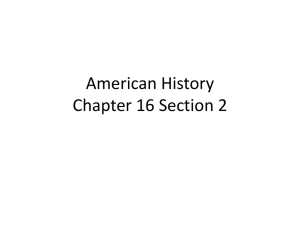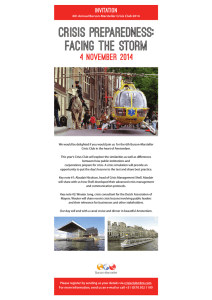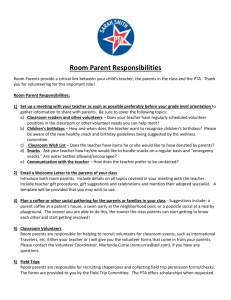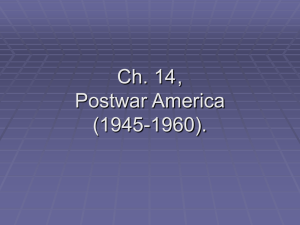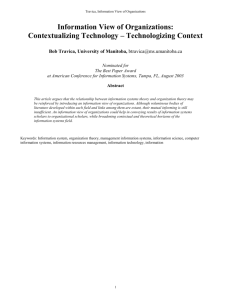The 1718 Galbraiths Supplement
advertisement
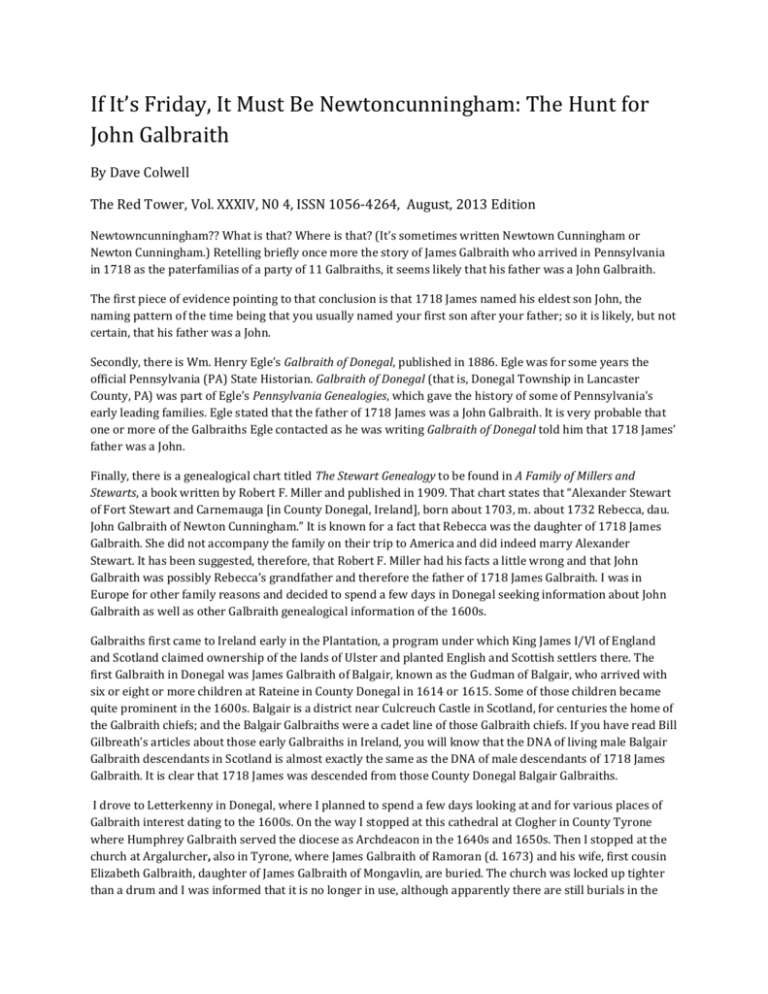
If It’s Friday, It Must Be Newtoncunningham: The Hunt for John Galbraith By Dave Colwell The Red Tower, Vol. XXXIV, N0 4, ISSN 1056-4264, August, 2013 Edition Newtowncunningham?? What is that? Where is that? (It’s sometimes written Newtown Cunningham or Newton Cunningham.) Retelling briefly once more the story of James Galbraith who arrived in Pennsylvania in 1718 as the paterfamilias of a party of 11 Galbraiths, it seems likely that his father was a John Galbraith. The first piece of evidence pointing to that conclusion is that 1718 James named his eldest son John, the naming pattern of the time being that you usually named your first son after your father; so it is likely, but not certain, that his father was a John. Secondly, there is Wm. Henry Egle’s Galbraith of Donegal, published in 1886. Egle was for some years the official Pennsylvania (PA) State Historian. Galbraith of Donegal (that is, Donegal Township in Lancaster County, PA) was part of Egle’s Pennsylvania Genealogies, which gave the history of some of Pennsylvania’s early leading families. Egle stated that the father of 1718 James was a John Galbraith. It is very probable that one or more of the Galbraiths Egle contacted as he was writing Galbraith of Donegal told him that 1718 James’ father was a John. Finally, there is a genealogical chart titled The Stewart Genealogy to be found in A Family of Millers and Stewarts, a book written by Robert F. Miller and published in 1909. That chart states that “Alexander Stewart of Fort Stewart and Carnemauga [in County Donegal, Ireland], born about 1703, m. about 1732 Rebecca, dau. John Galbraith of Newton Cunningham.” It is known for a fact that Rebecca was the daughter of 1718 James Galbraith. She did not accompany the family on their trip to America and did indeed marry Alexander Stewart. It has been suggested, therefore, that Robert F. Miller had his facts a little wrong and that John Galbraith was possibly Rebecca’s grandfather and therefore the father of 1718 James Galbraith. I was in Europe for other family reasons and decided to spend a few days in Donegal seeking information about John Galbraith as well as other Galbraith genealogical information of the 1600s. Galbraiths first came to Ireland early in the Plantation, a program under which King James I/VI of England and Scotland claimed ownership of the lands of Ulster and planted English and Scottish settlers there. The first Galbraith in Donegal was James Galbraith of Balgair, known as the Gudman of Balgair, who arrived with six or eight or more children at Rateine in County Donegal in 1614 or 1615. Some of those children became quite prominent in the 1600s. Balgair is a district near Culcreuch Castle in Scotland, for centuries the home of the Galbraith chiefs; and the Balgair Galbraiths were a cadet line of those Galbraith chiefs. If you have read Bill Gilbreath’s articles about those early Galbraiths in Ireland, you will know that the DNA of living male Balgair Galbraith descendants in Scotland is almost exactly the same as the DNA of male descendants of 1718 James Galbraith. It is clear that 1718 James was descended from those County Donegal Balgair Galbraiths. I drove to Letterkenny in Donegal, where I planned to spend a few days looking at and for various places of Galbraith interest dating to the 1600s. On the way I stopped at this cathedral at Clogher in County Tyrone where Humphrey Galbraith served the diocese as Archdeacon in the 1640s and 1650s. Then I stopped at the church at Argalurcher, also in Tyrone, where James Galbraith of Ramoran (d. 1673) and his wife, first cousin Elizabeth Galbraith, daughter of James Galbraith of Mongavlin, are buried. The church was locked up tighter than a drum and I was informed that it is no longer in use, although apparently there are still burials in the church graveyard. The gravestones of James and Elizabeth are inside the church, so I was not able to view them. Newtowncunningham was part of the land grant given to John Cunningham of Crawfield, later Sir John, in 1610. Pynnar’s Survey of 1619 notes that “he hath built a Town,” which was the origin of Newtowncuncungham. There were no Galbraiths noted among his original tenants there (although there were an Alexander Colewell and an Andrew Calwell, who could have been ancestors of mine). This is the sign along the road as you enter Newtowncunningham. Sadly, I confess that if the ghost of John Galbraith yet dwells in the village of Newtowncunningham, that ghost chose not to communicate with me. Since I found no trace of John Galbraith there, I thought I would try to find out more information about others among the many 1600s Galbraiths in Donegal. I spoke in person or over the telephone, sometimes at length over the telephone, with individuals who were genealogists or historians or who I thought might have knowledge of County Donegal in the 1600s. One person would lead me to another. One individual took me to an old forge behind an old house, which might have been 200 or 300 years old. There some earlier Galbraiths had produced agricultural implements, plows and so forth, some of which they exported to America. Some CGA members may have knowledge of such activity among their ancestors. If I talked to a Catholic individual, they might mention the Kennedys. One man had studied the history and life of former Speaker of the House of Representatives, Tip O’Neill. I spoke to a Presbyterian individual whose name was McKinley. He said he was distantly related to President McKinley, assassinated more than 100 years ago. He told me also that Woodrow Wilson’s family had come from Strabane, just across the River Foyle from County Donegal. The ties of the Irish to America are remembered and endure. None of those to whom I talked had any specific knowledge of those early Galbraiths or indeed of the history of Donegal during the Plantation. I explored some around Newtowncunningham. On a really small back road on the way to St. Johnston a few miles from Newtowncunningham I found the old Taughboyne (Church of Ireland) church. There was a chart posted in the graveyard which indicated the location of each grave. Among them were three Galbraith graves. I found them but I couldn’t make out what the weathered gravestones said, although I did see a date, which looked like 18??. That of course was too late for 1718 James. After James Galbraith, Gudman of Balgair, settled at Rateine, his eldest son, another James Galbraith, acquired property in the nearby townland of Mongavlin in the parish of Taughboyne. The 1659 Census of Ireland described the Barony of Raphoe, in which was situated the parish of Taughboyne. At the end of that part of the census there is the sentence: “There noe more houses of note in the Barony of Rapho save ye house of Magevelin situate on Lochfoile belonging to ye Lord Aubigny in ye p’ish of Taboine.” James’s land was not far from “ye house.” “Ye house” was actually a castle, a small one to be sure, which had once been the home of Ineenduv MacDonnell, the mother of the Earl of Tyrconnel, one of the earls whose 1607 flight led to King James I/VI’s claim that all the land of Ulster had been forfeited to him. She had been ousted from the castle by a son-in-law, but he in turn was displaced, for the castle was part of the land grant given by King James to the Duke of Lenox in 1610. Lord Aubigny, whose family held a previously acquired French title, was a cousin of the Duke of Lenox who gave him the castle. Aubigny later himself became the duke. Both Lenox and Aubigny were cousins of King James. Here is the castle today, or rather it’s ruins. The appropriate expression in Latin is Sic semper Gloria mundi (thus always passes away the glory of the world). What then? I looked for Galbraiths in the local phonebook at the hotel in Letterkenny where I was staying. There were not very many of them, but I got lucky and picked a Galbraith whose address was listed as Craigadoes, remembering that the 1665 Hearth Money Roll listed a Galbraith at Creghadow, which I supposed was the same place. That Galbraith turned out to be Isobel Galbraith, the widow of Bert Galbraith. In the Summer 1985 edition of The Red Tower there is an article setting forth some Irish explorations and research by Pat D’Arcy, one of the early serious Clan Galbraith Association genealogists and a great-aunt of current CGA member Eve Gray of Australia. Pat D’Arcy reported that she called on Bertie (Albert) Galbraith of Lower Craigiedoes. The Isobel I contacted was his widow. Her husband was one of four brothers, of whom three had passed away. Leslie, her brother-in- law, the only one still alive, lived with his family in Strabane, just across the River Foyle in County Tyrone. Ultimately, Isobel and her son, another Bert, took me to the home of Leslie and Mary Galbraith outside Strabane; there I enjoyed warm hospitality and had a very good lunch. They knew something of their ancestry, but the earliest date they had for any ancestors was 1774. That was no help in finding the ancestry of 1718 James. I did provide them with a written summary of what we now know about the 1600s Donegal Galbraiths, in which they were much interested. There are doubtless historians and genealogists who know much of the history of Donegal in the 1600s, but I did not encounter them. The Galbraiths in Strabane and the many other individuals to whom I talked knew little of the early years of the Plantation after 1610; no one knew anything of the prominent Galbraiths in Donegal in the 1600s. Leslie did tell me that the three graves at the Taughboyne church were of his ancestors. So . . . what of the hunt for John Galbraith, possible father of 1718 James? There is no John Galbraith known to us who could have been the father of 1718 James. There was a John Galbraith, son of Gudman James Galbraith. But that John and his immediate descendants did not leave Ireland and come to America in 1718. Here then is a theory, which I put forward once before in a Red Tower article. I believe that John Galbraith, putative father of 1718 James, was a natural (illegitimate) Galbraith son. Natural children were not all that uncommon in those days. I learned something while I was in Ireland. If a natural child was born to a woman, she brought that child up and he took her last name. John Galbraith, then, might have been such a natural son. But that John carried the Balgair Galbraith DNA, since the DNA of 1718 James and his descendants matches the DNA of Scottish Balgair Galbraith descendants. Women did not carry that DNA. Aha! If John Galbraith was the natural son of a Galbraith woman, then the father of that natural son must have been himself a Balgair Galbraith descendant. Thinking about those times, James Galbraith of Mongavlin and his brother, Robert of Dooish, as well as their brother Andrew, left home and served several times on the continent in the 1620s and 1630s during the Thirty Years War. James as an Irish M.P. was away for months in Dublin. And during the 1640s most of the Bal-gair descendant Galbraith men in Donegal were away from home for extended periods fighting the native Irish and later the forces of Parliament. Might a Galbraith brother-in-law, uncle or cousin have fathered a John Galbraith with a married Galbraith lady or which a married or unmarried Galbraith daughter during those times? Well, I don’t suppose people were any better or any worse 400 years ago than they are today, so that is certainly possible. Who might the father have been? Archdeacon Humphrey, an Anglican cleric, was something else again. He had killed the high sheriff of County Ferman-agh in a brawl, joined the fighting against the native Irish after 1641, and even went to England to fight Cromwell’s forces. He never married until he was about 35. He might have been the father. Then there was James Galbraith of Ramoran who did not marry until he was about 30, when he wed his cousin, Elizabeth Galbraith, who had been a widow for 10 years. He could have fathered a son with a Galbraith woman before he was married. Or Archibald, his brother, who never married, might have fathered a son with a female Galbraith cousin. There are many possibilities. Although natural children were not unknown in those days, they almost never appeared in the historical record or in wills. In any case, all the official records of the 1600s are long gone, including records of baptisms and marriages, which might provide some pertinent information. We know that 1718 James had to have significant financial resources in order to bring a party which included 10 other Galbraiths with him to Pennsylvania. How did that happen? Suppose an unmarried Galbraith daughter of, say, James Galbraith of Mongavlin, or Robert Galbraith of Dooish, or James Galbraith of Ramoran, for example, gave birth to a natural son, fathered by some Balgair Galbraith descendant man, and that daughter later married someone else. Perhaps the little boy stayed with his grandparents when the daughter left home with her new husband. Those grandparents might have grown to care for the boy. They might well have provided him with significant funds, which financed that trip to America. James Galbraith of Ramoran was probably the wealthiest of those 1600s Galbraiths since he had received much property in compensation for the losses he had sustained fighting for the royalist cause in the 1640s. Perhaps he fathered that John Galbraith. There is a theory. Is it a house of cards? Perhaps. Is it made of smoke? Perhaps. Is it full of unprovable speculation? Yes. It is mostly built on negative evidence: the father of 1718 James was very likely a John Galbraith, but there is no John in the historical record who could be the father of 1718 James. So this theory provides a John. It will take a better genealogical researcher than me (who would not be hard to find) to discover the truth of this matter. Or perhaps some papers belonging to another family will be unearthed at PRONI (The Public Records Office of Northern Ireland) or at the archives in Dublin, which may shed some light on the identity of 1718 James’s father. Until then the true identity of John, probable father of 1718 James, will be lost in the mists of time.
